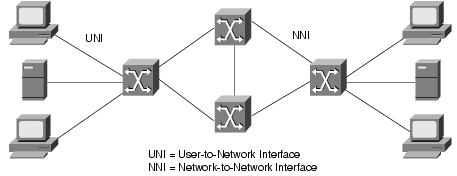Asynchronous Transfer Mode (ATM) is a cell relay, packet switching network and data link layer protocol which encodes data traffic into small (53 bytes; 48 bytes of data and 5 bytes of header information) fixed-sized cells. ATM provides data link layer services that run over Layer 1 links. This differs from other technologies based on packet-switched networks (such as the Internet Protocol or Ethernet), in which variable sized packets (known as frames when referencing layer 2) are used. ATM is a connection-oriented technology, in which a logical connection is established between the two endpoints before the actual data exchange begins.
Integrated Services Digital Network (ISDN) is comprised of digital telephony and data-transport services offered by regional telephone carriers. ISDN involves the digitization of the telephone network, which permits voice, data, text, graphics, music, video, and other source material to be transmitted over existing telephone wires. The emergence of ISDN represents an effort to standardize subscriber services, user/network interfaces, and network and internetwork capabilities. ISDN applications include high-speed image applications (such as Group IV facsimile), additional telephone lines in homes to serve the telecommuting industry, high-speed file transfer, and videoconferencing. Voice service is also an application for ISDN.
The ATM reference model, which has two forms - one for the user-to-network interface (UNI) and the other for the network-to-node interface (NNI), is divided into three layers: the ATM adaptation layer (AAL), the ATM layer, and the physical layer. The AAL interfaces the higher layer protocols to the ATM Layer, which relays ATM cells both from the upper layers to the ATM Layer and vice versa. When relaying information received from the higher layers, the AAL segments the data into ATM cells. When relaying information received from the ATM Layer, the AAL must reassemble the payloads into a format the higher layers can understand. This is called Segmentation and Reassembly (SAR). Different AALs are defined in supporting different types of traffic or service expected to be used on ATM networks.
The ATM layer is responsible for relaying cells from the AAL to the physical layer for transmission and from the physical layer to the AAL for use at the end systems, it determines where the incoming cells should be forwarded to, resets the corresponding connection identifiers and forwards the cells to the next link, as well as buffers cells, and handles various traffic management functions such as cell loss priority marking, congestion indication, and generic flow control access. It also monitors the transmission rate and conformance to the service contract (traffic policing).
The physical layer of ATM defines the bit timing and other characteristics for encoding and decoding the data into suitable electrical/optical waveforms for transmission and reception on the specific physical media used. In addition, it also provides frame adaptation function, which includes cell delineation, header error check (HEC) generation and processing, performance monitoring, and payload rate matching of the different transport formats used at this layer. SONET, DS3, Fiber, twisted-pair are few media often used at the physical layer.
Structure of an ATM cell

Structure of an ATM Network
ATM is based on the concept of two end-point devices communicating by means of intermediate switches. As Figure shows, an ATM network is made up of a series of switches and end-point devices. The end-point devices can be ATM-attached end stations, ATM-attached servers, or ATM-attached routers.

As Figure shows, there are two types of interfaces in an ATM network:
User-to-Network Interface (UNI)
Network-to-Network Interface (NNI)
The UNI connection is made up of an end-point device and a private or public ATM switch. The NNI is the connection between two ATM switches. The UNI and NNI connections can be carried by different physical connections.
